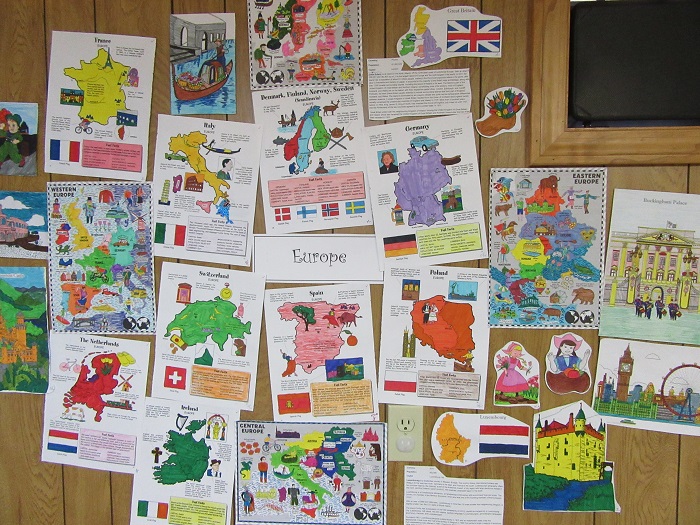
At the end of the gospel of Matthew, we have the words of the Lord, “Go ye therefore and teach all nations . . . to observe all things whatsoever I have commanded you.” How do we teach our children to be world changers while spending the bulk of our time at home? And how do we encourage them to be interested in the peoples and cultures of the world God has made without fostering worldliness? Here are a few ways that we have found to constructively bring the world home:
1. Invest in maps, a globe, and an atlas. – Since our children were very young, we have always had a country map and a world map prominently displayed in the kitchen, a globe within reach in the living room, and a couple of atlases on the reference shelf (one a modern atlas of countries of the world, the other a historical atlas showing Bible lands). When your children are young and you are talking about a people group, an event, a war, or a landmark, make it a habit to get up and point out the region you are talking about. When they are old enough to read and have a little familiarity with the maps and globe, ask them to get up and locate a particular country or body of water and point it out to the rest of the family. God has given children the gift of curiosity. If you establish the habit of “looking it up” as a family, most children will assume this habit on their own in time.
2. Keep a current missions board. – This will cost you nothing but space and time (unless you choose to purchase a bulletin board or whiteboard for it, which would cost up front but would also last for years. We’ve had the same bulletin board and whiteboard in constant use for over twenty years actually!). But it doesn’t have to be fancy. Any space you can set aside for the purpose will work. As you read news stories about missions work or world events or as you’re going through fundraising letters from various organizations or as you come across prayer needs overseas, keep an eye out for things that are particularly appropriate for and of interest to the age group of children that you have. Print or clip these articles (with pictures when possible) and display them. The key to keeping them interested in the missions board is to keep it fresh—as new things come in, post them. From time to time, look over the board and take down things that have been hanging too long. I like to put anything that I’m taking down with my Bible so that we can make sure to pray for those people or needs again before throwing the articles away or passing them on.
3. Travel or seek out local but “exotic” experiences. – Not everybody will be able to travel far. We happen to live in a state that borders another country, so we’ve been blessed to be able to travel internationally just by spending a few hours in the car. But even in a rural area, opportunities abound for coming into contact with other people groups and cultures if you are willing to look for them. For example, within the last two years, we were able to visit another church to hear a missionary speak on Chinese culture and return another evening to hear a different missionary speak about life in the Netherlands; we hosted a language night for our homeschool group, where everyone was invited to come share something in a foreign language that they know or are learning; we invited missionaries from Ireland over for a meal, and they brought pictures and stories of their work in the UK; we tried a traditional Jewish dish (shakshuka) made by our eldest daughter from a recipe shared by her Hebrew tutor; we met retired missionaries at a church dinner and were able to hear a little about their previous work in South America and enjoy some handbell music they shared with the children; and we attended a community “Christmas Around the World” event.
4. Build a shoebox for Operation Christmas Child. – This has been and continues to be one of my favorite ways to teach our children to be world disciple makers. Your family can pack a shoebox that has the potential to impact a child and family on the other side of the world. Every child that receives a shoebox receives an introduction to the gospel of Jesus Christ (and where possible, the invitation is also given to enroll in The Greatest Journey discipleship program). If you choose to get a tracking number for your box, Samaritan’s Purse will let you know what country your box was sent to, and your family can find out more about that country as you pray for that child and the needs of his or her community.
5. Support a missionary. – If you are able, support a missionary or a mission work overseas. Don’t just give money once a month, but undergird the family or work with your prayers. Keep abreast of their needs and see how the Lord might be willing to use you to help them. Some missionaries love to have short-term help from time to time (this can even be in the form of something done from home, such as stuffing envelopes with updates, helping them make other contacts locally for fundraising, etc.); others might be able to use specific supplies; all can use consistent support, prayer, and encouragement. There is a Christian wife and mother we know whose children are grown and who has begun going to Kenya on short-term medical mission trips a couple times a year. In her last newsletter she mentioned how they love to take pencils and stickers to give out to the children there. This caught my attention, and I was able to write and ask if we could send her a few pencils and stickers for her next trip. Will it be a large savings to her financially? No—but it says, “Hey, somebody read my update and cares for these people like I do! Somebody’s interested in the work the Lord has called me to do and will be praying for me!” Another way to encourage your missionary is to have the children make cards. Overseas postage can be significant for a package, but if what you are shipping is flat and fits in a standard envelope or a card-sized envelope, it is generally more reasonable.
6. Keep a running prayer map. – Every month or two we print out a simple one-page outline of the world and use it to keep track of prayer needs. When someone calls us for prayer or we learn about a request at church or from friends, we place it on the map. Then every morning when we pray, we either assign requests from the map or let the children each choose a couple needs to pray for. It’s a simple way to keep track of prayer requests, but it’s also a continual visual reminder that their prayers have the potential to literally change the world!

7. Look for puzzles, games, coloring books, and projects with a world focus. – We’ve never used a formal geography curriculum but rather have explored geography through map puzzles, card and trivia games, coloring pages, and occasional mapwork printouts. If you are willing to preview media, you can also find slideshows or documentaries that will add to your study of geography. We recently enjoyed a slideshow together that featured beautiful landmarks of Africa, giving a short description of each and detailing in which country it is located. A special geography project the children undertook this past year was to cover the walls of our fellowship room with maps and pictures representing each continent. While their hands were busy coloring in borders and landmarks, I was reading aloud good literature so their minds would be occupied as well. Some of the stories we read were from specific regions to go along with the continent we were currently studying, but much of the time, we just continued with the literature I had already planned to read this year. The mind will make its own connections—we don’t have to stress as mothers about always having one subject “line up” with another.
8. Read excellent biographies. – Biographies are exceptional tools for introducing your children to various lands and peoples in the world! Not only does a child have opportunity to learn about another time, place, and culture, but (if you choose your person wisely) there will also be a compelling figure for them to associate this newfound knowledge with and be able to remember it better. Investing in a series of individual country books designed for children (or borrowing a few at a time from the local library) can also be a way to discover some of the most important historical events, landmarks, customs, and holidays of another country. These often include full-color photographs, which help to hold interest and bring the text to life.
9. Learn a new language. – Learning a new language can give you the opportunity to meet new people, to speak into their lives and allow them to speak into yours, and to discover a culture different from your own. I’ve been studying French for years myself, and we’ve also had times of studying it as a family. God has allowed some amazing connections to stem from that. My older girls have a sweet friend in Québec, our whole family has become friends with several families in an Acadian region of New Brunswick and has been allowed the opportunity to pray for and encourage the work God is doing to build an evangelical French-speaking church there, and I’ve had the opportunity in language-learning sessions to speak about faithful marriage, child training, and homeschooling with dozens of European tutors over time. Even if your children don’t choose to pursue the same language that interests you (when they’re older), you will have given them the foundational skills for acquiring another language on their own.
10. Sponsor a child in another country. – Over time we have had the privilege of sponsoring different children from places as diverse as Guatemala, India, and South Sudan. While this is an obvious help to the child being sponsored, it is also an opportunity for spiritual growth in our children. The fact that it is another child that is being sponsored can open your children’s eyes to the reality that not everybody has the benefits and blessings they take for granted. One of our older sons has been particularly drawn to the child we are currently sponsoring and remembers consistently to pray for him and for his country. It is a good thing when a child learns to look outside of himself and his own needs and wants and participates in bearing another’s burden. For us, the most important things to know before beginning a sponsorship are these: Is the agency that is running a program both Christ-centered and reputable? How often will I receive updates on the child? What contact will I be allowed with the child, if any? and How long a commitment am I making?
I hope you come away from this article with the spark of a new idea about how to raise your children to reach the world for Christ. At its heart, homeschooling is not about academics—it’s about discipleship. And well-trained disciples have the potential to become disciple makers in their own community and around the world.
|
 |
 |
| recent missions board and map display | ||












